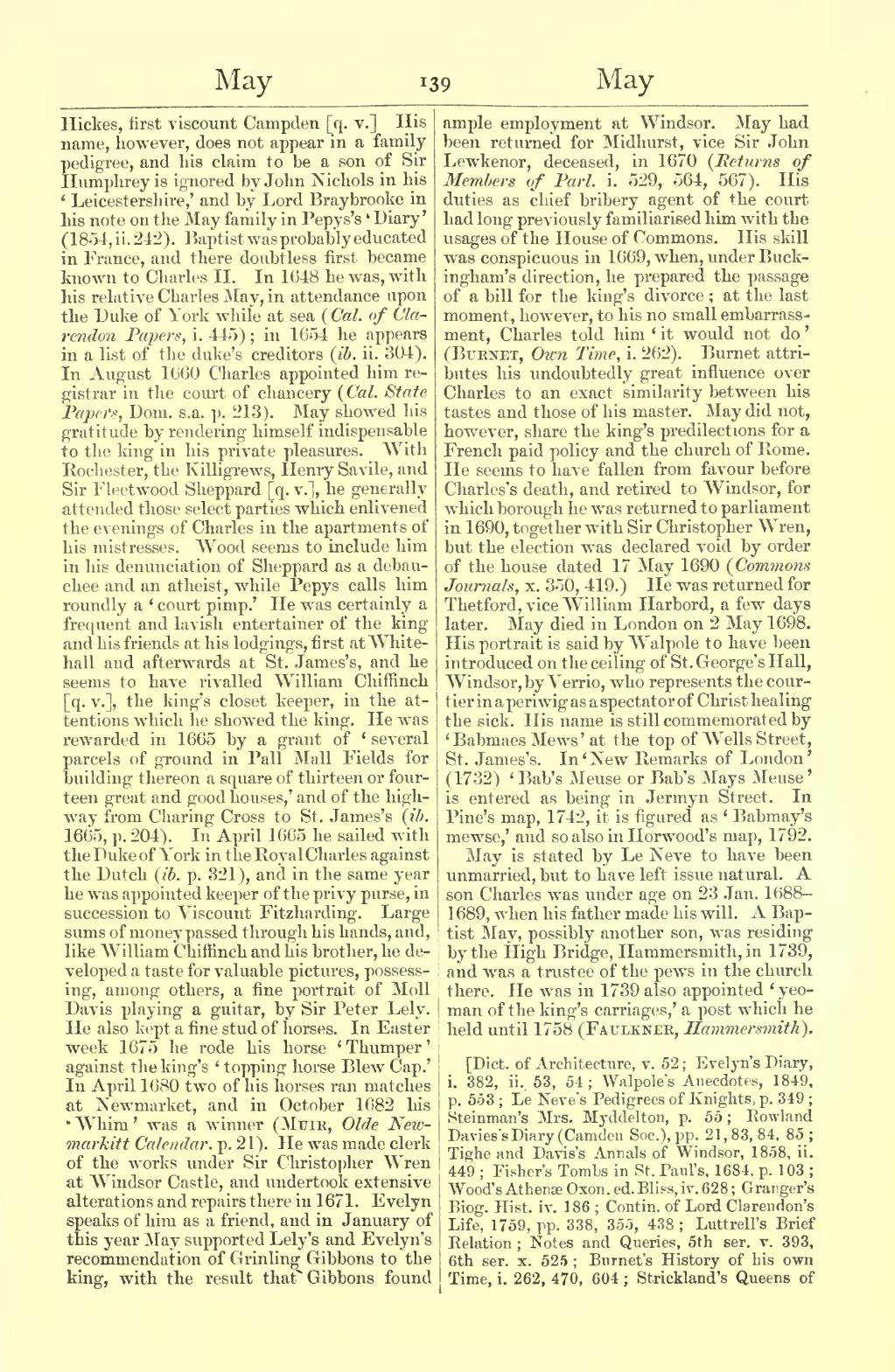Hickes, first viscount Campden [q. v.] His name, however, does not appear in a family pedigree, and his claim to be a son of Sir Humphrey is ignored by John Nichols in his ‘Leicestershire,’ and by Lord Braybrooke in his note on the May family in Pepys's ‘Diary’ (1854, ii. 242). Baptist was probably educated in France, and there doubtless first became known to Charles II. In 1648 he was, with his relative Charles May, in attendance upon the Duke of York while at sea (Cal. of Clarendon Papers, i. 445); in 1654 he appears in a list of the duke's creditors (ib. ii. 304). In August 1660 Charles appointed him registrar in the court of chancery (Cal. State Papers, Dom. s.a. p. 213). May showed his gratitude by rendering himself indispensable to the king in his private pleasures. With Rochester, the Killigrews, Henry Savile, and Sir Fleetwood Sheppard [q. v.], he generally attended those select parties which enlivened the evenings of Charles in the apartments of his mistresses. Wood seems to include him in his denunciation of Sheppard as a debauchee and an atheist, while Pepys calls him roundly a ‘court pimp.’ He was certainly a frequent and lavish entertainer of the king and his friends at his lodgings, first at Whitehall and afterwards at St. James's, and he seems to have rivalled William Chiffinch [q. v.], the king's closet keeper, in the attentions which he showed the king. He was rewarded in 1665 by a grant of ‘several parcels of ground in Pall Mall Fields for building thereon a square of thirteen or fourteen great and good houses,’ and of the highway from Charing Cross to St. James's (ib. 1665, p. 204). In April 1665 he sailed with the Duke of York in the Royal Charles against the Dutch (ib. p. 321), and in the same year he was appointed keeper of the privy purse, in succession to Viscount Fitzharding. Large sums of money passed through his hands, and, like William Chiffinch and his brother, he developed a taste for valuable pictures, possessing, among others, a fine portrait of Moll Davis playing a guitar, by Sir Peter Lely. He also kept a fine stud of horses. In Easter week 1675 he rode his horse ‘Thumper’ against the king's ‘topping horse Blew Cap.’ In April 1680 two of his horses ran matches at Newmarket, and in October 1682 his ‘Whim’ was a winner (Muir, Olde Newmarkitt Calendar, p. 21). He was made clerk of the works under Sir Christopher Wren at Windsor Castle, and undertook extensive alterations and repairs there in 1671. Evelyn speaks of him as a friend, and in January of this year May supported Lely's and Evelyn's recommendation of Grinling Gibbons to the king, with the result that Gibbons found ample employment at Windsor. May had been returned for Midhurst, vice Sir John Lewkenor, deceased, in 1670 (Returns of Members of Parl. i. 529, 564, 567). His duties as chief bribery agent of the court had long previously familiarised him with the usages of the House of Commons. His skill was conspicuous in 1669, when, under Buckingham's direction, he prepared the passage of a bill for the king's divorce; at the last moment, however, to his no small embarrassment, Charles told him ‘it would not do’ (Burnet, Own Time, i. 262). Burnet attributes his undoubtedly great influence over Charles to an exact similarity between his tastes and those of his master. May did not, however, share the king's predilections for a French paid policy and the church of Rome. He seems to have fallen from favour before Charles's death, and retired to Windsor, for which borough he was returned to parliament in 1690, together with Sir Christopher Wren, but the election was declared void by order of the house dated 17 May 1690 (Commons' Journals, x. 350, 419). He was returned for Thetford, vice William Harbord, a few days later. May died in London on 2 May 1698. His portrait is said by Walpole to have been introduced on the ceiling of St. George's Hall, Windsor, by Verrio, who represents the courtier in a periwig as a spectator of Christ healing the sick. His name is still commemorated by ‘Babmaes Mews’ at the top of Wells Street, St. James's. In ‘New Remarks of London’ (1732) ‘Bab's Meuse or Bab's Mays Meuse’ is entered as being in Jermyn Street. In Pine's map, 1742, it is figured as ‘Babmay's mewse,’ and so also in Horwood's map, 1792.
May is stated by Le Neve to have been unmarried, but to have left issue natural. A son Charles was under age on 23 Jan. 1688–1689, when his father made his will. A Baptist May, possibly another son, was residing by the High Bridge, Hammersmith, in 1739, and was a trustee of the pews in the church there. He was in 1739 also appointed ‘yeoman of the king's carriages,’ a post which he held until 1758 (Faulkner, Hammersmith).
